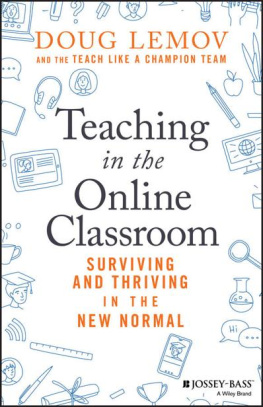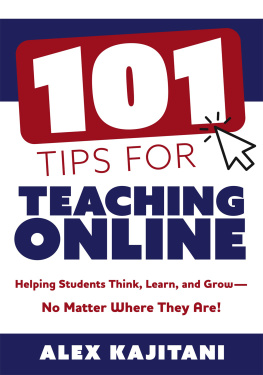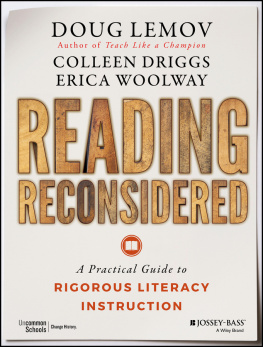Doug Lemov - Teaching in the Online Classroom
Here you can read online Doug Lemov - Teaching in the Online Classroom full text of the book (entire story) in english for free. Download pdf and epub, get meaning, cover and reviews about this ebook. year: 2020, publisher: Wiley, genre: Home and family. Description of the work, (preface) as well as reviews are available. Best literature library LitArk.com created for fans of good reading and offers a wide selection of genres:
Romance novel
Science fiction
Adventure
Detective
Science
History
Home and family
Prose
Art
Politics
Computer
Non-fiction
Religion
Business
Children
Humor
Choose a favorite category and find really read worthwhile books. Enjoy immersion in the world of imagination, feel the emotions of the characters or learn something new for yourself, make an fascinating discovery.
- Book:Teaching in the Online Classroom
- Author:
- Publisher:Wiley
- Genre:
- Year:2020
- Rating:3 / 5
- Favourites:Add to favourites
- Your mark:
- 60
- 1
- 2
- 3
- 4
- 5
Teaching in the Online Classroom: summary, description and annotation
We offer to read an annotation, description, summary or preface (depends on what the author of the book "Teaching in the Online Classroom" wrote himself). If you haven't found the necessary information about the book — write in the comments, we will try to find it.
Teaching in the Online Classroom — read online for free the complete book (whole text) full work
Below is the text of the book, divided by pages. System saving the place of the last page read, allows you to conveniently read the book "Teaching in the Online Classroom" online for free, without having to search again every time where you left off. Put a bookmark, and you can go to the page where you finished reading at any time.
Font size:
Interval:
Bookmark:
Online Classroom
Doug Lemov and the Teach Like a Champion Team

Copyright 2020 by Doug Lemov. All rights reserved.
JosseyBass
A Wiley Imprint
111 River St, Hoboken, NJ 07030
www.josseybass.com
No part of this publication may be reproduced, stored in a retrieval system, or transmitted in any form or by any means, electronic, mechanical, photocopying, recording, scanning, or otherwise, except as permitted under Section 107 or 108 of the 1976 United States Copyright Act, without either the prior written permission of the Publisher, or authorization through payment of the appropriate percopy fee to the Copyright Clearance Center, Inc., 222 Rosewood Drive, Danvers, MA 01923, phone +1 978 750 8400, fax +1 978 750 4470, or on the web at www.copyright.com. Requests to the Publisher for permission should be addressed to the Permissions Department, John Wiley & Sons, Inc., 111 River Street, Hoboken, NJ 07030, phone + 1 201 748 6011, fax +1 201 748 6008, or online at www.wiley.com/go/permissions.
Limit of Liability/Disclaimer of Warranty: Although the publisher and author have used their best efforts in preparing this book, they make no representations or warranties with respect to the accuracy or completeness of the contents of this book and specifically disclaim any implied warranties of merchantability or fitness for a particular purpose. No warranty may be created or extended by sales representatives or written sales materials. The advice and strategies contained herein may not be suitable for your situation. You should consult with a professional where appropriate. Neither the publisher nor author shall be liable for any loss of profit or any other commercial damages, including but not limited to special, incidental, consequential, or other damages.
JosseyBass books and products are available through most bookstores. To contact JosseyBass directly, call our Customer Care Department within the U.S. at 8009567739, outside the U.S. at +1 317 572 3986, or fax +1 317 572 4002.
Wiley also publishes its books in a variety of electronic formats and by printondemand. Some material included with standard print versions of this book may not be included in ebooks or in printondemand. If this book refers to media such as a CD or DVD that is not included in the version you purchased, you may download this material at http://booksupport.wiley.com. For more information about Wiley products, visit www.wiley.com.
Library of Congress CataloginginPublication Data is Available:
ISBNs: 9781119762935 (paperback), 9781119762881 (ePub), 9781119762959 (ePDF)
Cover Design: Paul Mccarthy
Cover Art: Vasilkovs/Shutterstock.com
FIRST EDITION
Remote Teaching and the New Normal
Doug Lemov and Erica Woolway
There are a few tiny, beautiful moments in one of Eric Snider's remote English lessons with his students at Achievement First Iluminar Mayoral Academy Middle School in Cranston, Rhode Island. The class is reading Rita WilliamsGarcia's One Crazy Summer, and Eric asks if anyone is willing to try to answer a question that they know is difficult. Eric has already told them, calmly and without judgment, that many of them misunderstood a key passagethat the question they've been asked to answer is a hard one. Many of the students are undaunted, and they volunteer. Thanks, James. Thanks, George. Thanks, Jaylee, he says as each hand is raised. He's showing students that he sees them embrace the challenge. Soon, there are more volunteers. Wow, ton of hands here. I appreciate it.
It's a great moment, because it reminds us how important it is for people to feel seen. Telling someone how much you appreciate what they do in the face of challenges can help bring out their best, online as much as in person.
This moment also reminds us that the act of observing others can influence people's behavior. We becomeor can becomemore like what we choose to observe. The human body has about 11M sensory receptors, James Clear writes in Atomic Habits. Approximately 10M of those are dedicated to sighta small change in what you see can lead to a big shift in what you do. Good models are powerful.
The clip ends, as you will later see, with a student answering the difficult question beautifully and compellingly, from the back seat of her family's car. It's a difficult world right now, but she's managed to adapt, and she's brought her A game.
Teachers, too, have been asked to do what they know is difficult: to shift, without warning, to an unfamiliar universeone where we interact with our students remotely, as if through a tiny keyhole in the classroom door. Each of the young people we care about now appears as a small image in the corner of our computer screen (sometimes not even that).
Nearly everything about teaching has changed for teachers over the past few months except the fact that students need us. And so it's incumbent upon us a profession to learn new methods to reach them as quickly and effectively as possible.
This book is about applying the lessons of that moment from Eric's classroom to teachers. In it we'll show you, with appreciation, tiny moments from the classes of real teachers working online. We'll share insights and discuss principles from those examples to help you adapt as successfully as possible to our New Normal of remote teaching or some combination of remote and classroom education. And in doing so we hope to show our appreciation for you and for the teachers whose work we share.
No one asked for the world to change this way, but it has. As teachers, that means there's work to be done. If you're reading this, you realize and embrace that fact. We're grateful to you, and our goal is to pay you back for that commitment. And the good news is that it's not just that teachers have jumped in, in the face of difficulty, and done the work. It's that they have done the work and begun to find solutions to the difficult daytoday challenges of remote teaching. Whenever difficulty presents itself, there is always some teacher, somewhere, who finds a solution.
In facing new teaching challenges, it's important to remember that while so much of the work has changed (we all now know what Zoom is, for example), much also remains the same. The fundamentals of teaching and the relationships that we know from our previous lives still very much apply. Sometimes we just have to look harder or in different places to see it. As one friend described her life under quarantine, it is a New Normaltotally different but with at least an echo of the familiar.
Since this New Normal began, we've witnessed plenty of challenges in the classroomglitchy internet; good internet but some children lacking a device to access it; students participating from hallways outside their apartments; teachers leading classes with their own children in their lapsbut we have seen even more of a cando attitude, a problemsolving embrace of situations outside our control. There is less looking back over shoulders and more turning to face the future fullon.
It's important to underscore the urgency of this attitudethe absolute necessity of getting better at what we do now, no matter the circumstances.
A recent blog post by Brown University economist Emily Oster used data from her colleague John Freidman's research to show how critical the next months and years of our teaching lives will be. Friedman took data on student progress from the online math platform Zearn, charted it longitudinally, and disaggregated it by income level. Here's the chart:
Font size:
Interval:
Bookmark:
Similar books «Teaching in the Online Classroom»
Look at similar books to Teaching in the Online Classroom. We have selected literature similar in name and meaning in the hope of providing readers with more options to find new, interesting, not yet read works.
Discussion, reviews of the book Teaching in the Online Classroom and just readers' own opinions. Leave your comments, write what you think about the work, its meaning or the main characters. Specify what exactly you liked and what you didn't like, and why you think so.








